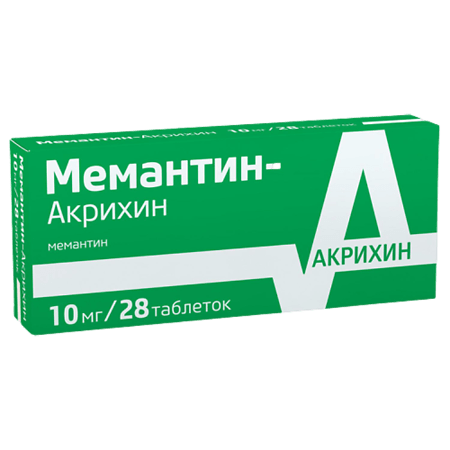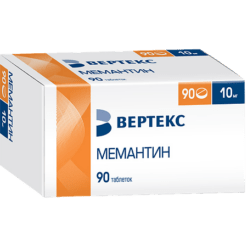No products in the cart.
Memantine, 10 mg 28 pcs.
€1.00
Out of stock
(E-mail when Stock is available)
Description
Pharmacodynamics
Memantine is a potential-dependent noncompetitive inhibitor of NMDA receptors with moderate affinity to them. It modulates the action of pathologically increased tonic glutamate, which can lead to neuronal dysfunction.
Pharmacokinetics
After oral administration, it is rapidly and completely absorbed. Maximum plasma concentration is reached 3-8 hours after ingestion.
The pharmacokinetics are linear in the dose range from 10 to 40 mg.
Daily administration of a daily dose of 20 mg results in equilibrium plasma concentrations of 70 to 150 ng/mL (0.5 to 1 μmol) with marked individual variation. The volume of distribution is about 10 l/kg. About 45% of memantine is bound to plasma proteins. No cumulation of the drug was noted in normal renal function.
About 80% of memantine is present in circulating blood as unchanged compound. The major metabolites are N-3,5-dimethyl-gludantane, a mixture of isomers of 4- and 6-hydroxy-memantine and 1-nitroso-3,5-dimethyl-adamantane. None of these metabolites has antagonistic activity toward NMDA receptors.
The involvement of cytochrome P450 in metabolism has not been identified in in vitro studies.
In studies with oral administration of 14C-memantine, on average 84% of the dose was excreted within 20 days, with over 99% of the drug excreted by the kidneys.
Memantine is excreted primarily by the kidneys. Excretion is monoexponential with a half-life of 60 to 100 hours. In studies in volunteers with normal renal function, total clearance was 170 ml/min/1.73 m2, a portion of total renal clearance was achieved by renal tubular secretion.
Renal excretion also includes tubular reabsorption, which is probably accomplished by cationic transport proteins. The rate of renal elimination under conditions of alkaline urine reaction can be reduced by a factor of 7-9.
The alkalinization of urine can be a consequence of a dramatic change in diet, such as a switch from eating predominantly meat products to vegetarianism, or due to heavy use of alkaline gastric buffers.
Pharmacokinetic-pharmacodynamic relationship:
At a maintenance dose of 20 mg/day, the level of memantine concentration in cerebrospinal fluid corresponds to the kj value (kj-inhibition constant), which for memantine is 0.5 μmol in the human frontal cortex.
Indications
Indications
Active ingredient
Active ingredient
Composition
Composition
How to take, the dosage
How to take, the dosage
Patients of elderly age (over 65 years)
Dose adjustment is not required.
Patients with impaired renal function
Dose adjustment is not required in patients with a creatinine clearance of 50-80 ml/min. For patients with moderate renal impairment (creatinine clearance 30-49 ml/min), the recommended daily dose is 10 mg/day. If this dose is well tolerated for 7 days, the dose can be increased to 20 mg/day according to the standard titration scheme.
In patients with severe renal insufficiency (creatinine clearance 5-29 ml/min) the daily dose should not exceed 10 mg/day.
Patients with hepatic impairment
In patients with mild to moderate hepatic impairment (Child-Pugh grades A and B) no dose adjustment is required. There are no data on the use of memantine in patients with severe hepatic impairment, so the prescription, memantine is not recommended in these patients.
Interaction
Interaction
Special Instructions
Special Instructions
The effect of the drug on the ability to drive vehicles, mechanisms
Patients with Alzheimer’s disease at the stage of moderate to severe dementia usually have impaired ability to drive vehicles and operate complex mechanisms. In addition, memantine may cause changes in reaction speed, so patients should refrain from driving or operating complex machinery.
Contraindications
Contraindications
Side effects
Side effects
Overdose
Overdose
In relatively large overdoses (200 mg once and 105 mg/day for 3 days), the following symptoms have been reported . fatigue, weakness, and/or diarrhea or no symptoms.
In cases of overdose of less than 140 mg once or when an unknown dose was taken, patients experienced adverse reactions from the central nervous system: confusion, hypersomnia, drowsiness, dizziness, agitation, aggression, hallucinations, gait disturbance) and/or from the digestive system: vomiting, diarrhea.
In the most severe case of overdose, the patient survived after taking a 2000 mg dose of memantine, he had central nervous system adverse reactions (coma for 10 days, then diplopia and agitation). The patient received symptomatic treatment and plasmapheresis. The patient recovered without further complications.
In another case of a severe overdose, the patient survived and recovered after receiving memantine at a dose of 400 mg once. The patient experienced central nervous system adverse reactions: anxiety, psychosis, visual hallucinations, decreased seizure threshold, drowsiness, stupor, and loss of consciousness.
Treatment:
In case of overdose treatment is symptomatic. There is no specific antidote. Standard therapeutic measures aimed at the elimination of the substance from the stomach, such as gastric lavage, intake of activated charcoal, acidification of the urine, possibly performing forced diuresis.
Pregnancy use
Pregnancy use
Similarities
Similarities
Additional information
| Shelf life | 2 years. |
|---|---|
| Conditions of storage | Store in a dry place protected from light at a temperature not exceeding 25 ° C. Keep out of reach of children! |
| Manufacturer | Polpharma S.A., Poland |
| Medication form | pills |
| Brand | Polpharma S.A. |
Other forms…
Related products
Buy Memantine, 10 mg 28 pcs. with delivery to USA, UK, Europe and over 120 other countries.
















